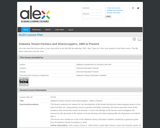
This resource provides instructional strategies for teaching chronological narratives.
- Subject:
- Social Studies
- Material Type:
- Activity/Lab
- Provider:
- Tarr's Toolbox
- Date Added:
- 08/17/2017

This resource provides instructional strategies for teaching chronological narratives.

This online textbook is designed for grade 8 and up and covers all of North Carolina history, from the arrival of the first people some 12,000 years ago to the present. There are eleven parts, organized chronologically, a collection of primary sources, readings, and multimedia that can be rearranged to meet the needs of the classroom. Special web-based tools aid reading and model historical inquiry, helping students build critical thinking and literacy skills.

In this lesson, students work in groups to examine excerpts from primary source documents. They identify social and economic factors affecting specific categories of people when the Great Migration accelerated in 1916 to 1917: black migrant workers from the South, southern planters, southern small-farm farmers, northern industrialists, agents, and white immigrant workers in the North. Each student group creates a "perspectives page" to post for a gallery walk where students analyze the causes of the Great Migration and the changes it brought to both the North and South. Students also discuss the specific economic factors that influenced the Great Migration: scarcity, supply, demand, surplus, shortage, and opportunity cost. Using the PACED decisionmaking model, they analyze the alternatives and criteria of potential migrants.

In this lesson, students will explore the complicated period of the conflict in Vietnam, focusing on the role of African Americans in the war as well as on the discrimination they simultaneously faced at home. Through class discussion, examination of an anti-war comic book, exploration of political cartoons, and review of a less famous speech by Martin Luther King, Jr., students will study the various African Americans who protested the Vietnam War as well as their reasons for doing so.

Containing more than 50 articles from the award-winning Tar Heel Junior Historian magazine and over 40 lesson plans, this multidisciplinary Educator Notebook will enrich your exploration of North Carolina and American history with diverse perspectives. This resource's link takes you to a very short form that gives you free downloadable access to the complete PDF book.

A website resource that provides facts and data that documents the forced removal of enslaved persons from Africa and their arrival to North Carolina.

In this lesson, students examine two reform movements - anti-slavery and women's rights. In addition to learning about the beliefs and motivations of each group, students will seek cultural connections among the various reform impulses.

This lesson explores the reasons for the development of the tenant farming and sharecropping system in the post-Civil War era. Using primary sources (pictures and labor contracts), the lesson presents some of the situations that caused the system to develop. It covers the lifestyle of the farmers and investigates the reasons for the decrease in the system of tenant farming and sharecropping after the Depression and World War II.

In this lesson, students understand the provisions of the Alien and Sedition Acts within their political and constitutional contexts. Students will explore the issues raised by the prosecutions under these acts and the larger constitutional issues they raised, including a comparison of antebellum political conflicts and current issues.

In this lesson, students learn about the Alien and Sedition Acts of 1798. Discussion questions are provided. In an associated activity, students extend their understanding by studying free speech and free press issues of the 20th century. Students will look up some of these important Supreme Court cases and report back to the class.

During the week, students will spend 10-12 minutes in both watching and annotating a video from www.history.com relating to a specific decade's historical and/or cultural developments and events.

Students will watch various documentary videos (10-12 minutes) about significant events in the United States in the 1990s. For each short video, students will complete a graphic organizer. Students will then engage in discussions with their peers about the documentaries using a set of predetermined questions and through a variety of suggested discussion strategies.

Using Project GLAD strategies, students will be able to analyze the foundations and development of American government in terms of principles and values.

This Unit is an 11th Grade Unit. It explains how the tensions over power and authority led America’s founding fathers to develop a constitutional democracy.

In this lesson, students will be divided into groups and asked to analyze and evaluate editorial cartoons pertaining to late 19th and early 20th century American imperialism. Students are expected to determine the perspective of the artists. After group evaluation, students will present their finding to the entire class.

With this digital collection, students will explore the wider, literary context for the canonical works of the American Renaissance. Students will consider the following essential questions: 1. What was the literary context in which canonical American Renaissance writers wrote and published? 2. What kinds of literature were popular in the mid-nineteenth-century United States? 3. How did now-canonical writers engage or respond to popular literary forms?

In this activity, students will delve into some of the revolutionary documents and consider the ideas of "authority" and "power" from the perspectives of those who had such a great stake in America's revolutionary struggle.

In this lesson, students will analyze lyrics of music from the Jacksonian era to be able to describe one aspect of the culture. Students will create their own lyrics to describe why social reform was needed.

In this lesson, students will compare/contrast the information in their textbook about Andrew Jackson to political cartoons of the era. Students will identify symbols, allusions and stereotypes used in these cartoons and infer the intended message and tone of the Jackson era cartoons. Students will also identify any biases in the cartoons and check for historical accuracy, and then formulate their own opinion about the Jackson Administration. As a culminating activity, students will write an opinion essay that articulates their personal stance on Andrew Jackson’s character, using proper writing conventions.

With this digital collection, students will explore the actions taken by abolitionists in Illinois and their reactions to national policies. Students will consider the following questions as they review the documents: 1. What motivated the actions of abolitionists in Illinois? 2. How did abolitionists attempt to transform public opinion on the issue of slavery? 3. How did the abolitionist movement evolve and respond to national events that shook the nation in the 1850s?